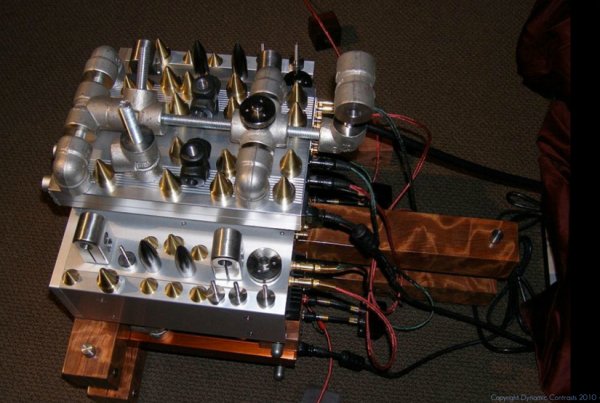I'm glad you heard an improvement, but I remain extremely sceptical about these types of tweaks. The whole idea of a piece of wood and some rubber discs (or whatever that material is) having magical properties just doesn't sit well with me.
JV, it's always healthy to remain skeptical, especially when it comes to high-end audio.
But there's nothing magical to it. In fact, these gents barely scratched the surface of this little experiment. In essence, what they accomplished with this tiny example of mass loading was help minimize the vibrations captured at the top plate of each amp. Top plates are generally thin stamped sheet metal or thin aluminum plates and often times secured by only a few screws to more rigid parts. This make the top plates among the most easily excitable component parts by vibrations. In fact, they are often times so easily excited, that they can vibration in sympathy with the air-borne and internally-generated (power supplies, motors, etc) vibrations already captured at the chassis. Thus taking a bad situation and making it even worse if that's possible.
Now in their example, they're only using a few pounds of mass-loading near the front or back ends and I'd guess that their best benefits would occur with these tiny weights smack dab in the middle. Perhaps in this case they realize more performance benefits if the mass-loading is closer to the vibrating power supply within, which may be toward the front or rear.
But if they swapped these tiny weights out and installed say 50 or 100 lbs. weights the system would be singing an entirely new song altogether. But that also would depend on the racks / stands underneath and what type of "footers" they're using sandwiched between the amps bottom plates and the stand.
If per chance they're using hard metal objects as footers / conductors between the bottom plate and the amp stands, and the amp stands are sufficiently rigid and they are locked into the sub-flooring, then mass-loading can also serve the dual purpose of also creating an inferior or superior mechanical conduit that allows mechanical vibrations previously trapped within the component chassis and forced to fully dissipate within the chassis, to now escape into the stand and hopefully into the sub-flooring before releasing their energy. Rather than inside the component. In any case, even a few measly pounds of mass loading is usually better for either purpose than no mass-loading at all.
Below is a picture of some early R&D I was doing about this subject back in 2007. Over the course of maybe 6 months I installed just a few pounds of scrap metal at a time and waited, then installed a few more pounds and waited, etc. and this went on until the entire top plates' real estate space was completely saturated. At which point I had to go to extremes and then far greater extremes to keep the experiment going.
Why did I wait each time after adding a few pounds to each top plate? Because in my config, with the materials I was using at the time there was a mechanical settling in period of roughly 53 hours (give or take 30 minutes) before I'd hear a sonic improvement.


